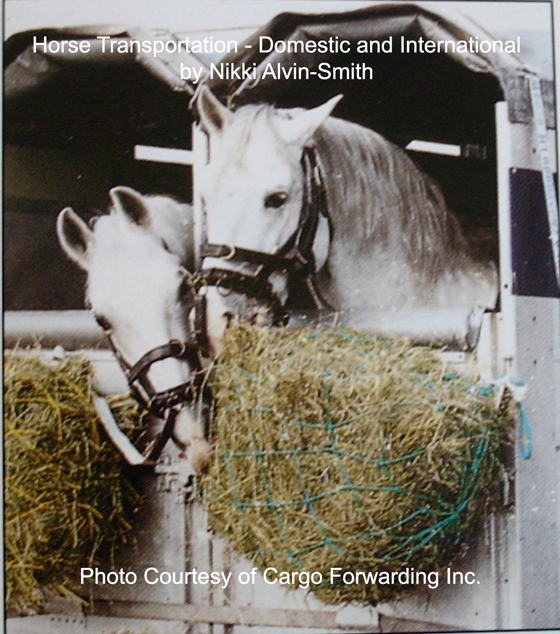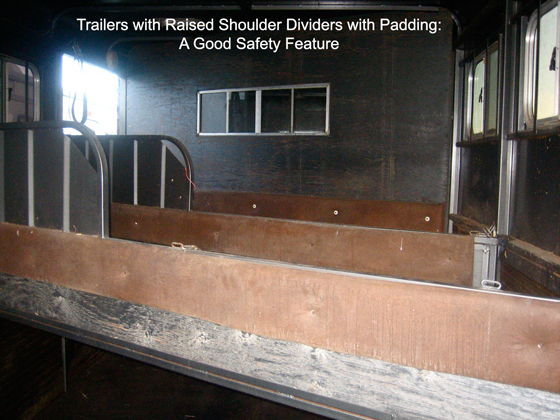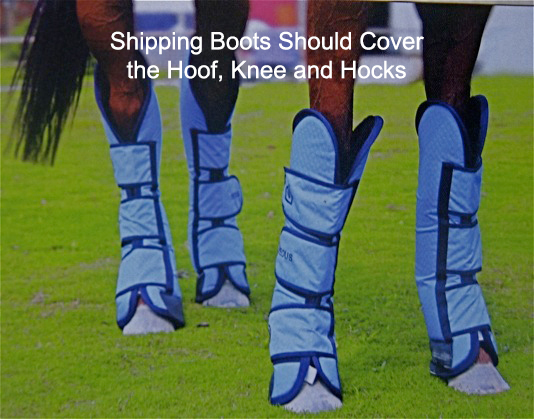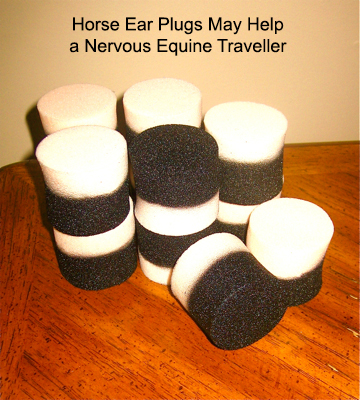Horse Transportation - Domestic & International
by Nikki Alvin-Smith.

If you have ever had a horse arrive at your farm with shipping fever, then you know how sad it makes you feel to know it could, in all likelihood, have been prevented.
In todays world of immediate information, there is no excuse not to do the math on how to best transport a horse. Either long distance, (and the United States certainly qualifies for that), short distance but delayed travel ( lots of parts of Europe, navigating huge American cities) or even internationally.
This author has traveled many times across the pond ( Atlantic Ocean) by airline with horses. Sometimes acting as airline groom help, sometimes as concerned owner. Horses all respond differently to air travel and by far the worst part of the ride is take off and landing. Horses that stand on a plane for hours often arrive with sore backs as they shuffle left and right continually during flight steadying their balance. Some arrive at their destination so stressed that they are completely zoned out on arrival and it takes several days for them to recover. Others arrive as high as helium balloons and act out immediately they are on 'terra firma.' But I digress. International transport is a whole other world and one which most horses never experience. Let's focus on domestic U.S.A. travel which is much more common.
If you don't have your own trailer and have to hire someone to transport your horse it is important that you address the following questions:-
Are they licensed?
Interstate carriers are required to fulfill a laundry list of special requirements: which naturally includes insurance, safety flares, triangles, medical kits, driver hours and mileage logs to name but a few. Their equipment often also requires a driver with a commercial drivers license. Often two drivers are required.
Are they insured?
If you are not using a commercial hauler but perhaps accessing a ride with a friend or local barn owner or perhaps catching a ride with your trainer to a show you should check they have insurance to cover your horse in an event of an accident. Beware of setting your horse off on a journey with a friend and not ensuring that their equipment is in good condition, but more on that later.
Are you insured?
If your horse inadvertently hurts someone while being loaded/unloaded or during the trip do you have liability protection against a damage suit? If you don't it is fairly easy to obtain as part of a membership to the United States Equestrian Federation (U.S.E.F.), American Horse Council through your local county office or through other equestrian organizations. If you have professional status ( you receive any type of payment for horse training services either by barter value or hard dollars) then these insurances will not apply. They are offered for amateur riders/owners only. You will need to purchase professional insurance. These insurances will not cover damage or death of your horse. For that you must have horse mortality and loss of use insurance and those insurances standardly do not cover international travel, for that you need a specific rider.
What is the condition of the equipment?
Make sure that the equipment is inspected and registered. With today's computer access folks that don't inspect but just register their trailers are quickly identified in the Department of Motor Vehicles system, but it is still up to you to check the equipment inspections and documentation is in date. This will mean the brakes have been checked, as well as tires for wear. For trailers the hitch and breakaway safety devices will also have been checked. It does not mean the ramps are good, that the compartment dividers are properly fixed or that the roof vents work. It is up to you to check these things and be happy with the condition. Commercial rigs offer many advantages. Air ride axles to smooth the ride, cameras to watch the horses during transport, air conditioning, thick rubber mats to reduce leg stress and many more.

What is the drivers experience?
Obviously first check is their driving experience. The number one rookie mistake trailer drivers make is to drive too fast especially around corners. Some drivers never learn to slow down gradually, avoid unnecessary hard stops or to handle on and off interstate ramps and winding country roads with due diligence. While it is illegal to travel yourself in an attached trailer, a quick stand on the trailer down the farm driveway will soon make you appreciate how tough it is to balance even if a horse has two more legs than we do. You will find yourself needing to hold onto the trailer dividers in short order. The driver should also allow longer stopping distances. It is a good idea to have some signage on the back of the trailer asking drivers to stay back and indicate that there are horses on board. But also consider the handler experience. Loading and unloading horses safely requires experience, patience, confidence and preferably two people.
Direction of travel?
Is the trailer a slant load or front/rear placement? The slant load trailers sometimes put additional stress on the stifles and one front foot of the horse more than another. Front/rear travel is generally preferred. Everyone has their own preference, but in recent years slant load has become less popular.
What other horses are on board?
Many trailers have raised shoulder dividers to prevent one horse from intimidating another but it is not always enough. Even if the horses are tied ( and they should not be tightly tied to enable freedom of head movement), they can still pin ears and even kick at each other. Obviously stallions and mares transported together can be a disaster. In airline travel stallions are often 'vicked up.' The application of Vicks Vapor Rub on their noses to prevent them being able to smell a mare in heat.
Medical paperwork?
Remember there are both State and Federal requirements and the State requirements vary considerably from State to State so check what you need. Health certificates dated within thirty days, proof of rabies vaccine and a current Coggins are usual minimal requirements. If you are trailering in company with a friend be sure their horses are up to date on their vaccinations too and be very wary of any horse that has come from an auction. Those horses need to be quarantined for thirty days and you do not want your horse sharing a trailer with a recent rescue horse that has come directly from an auction.
While it may seem a hassle to get the medical paperwork it is a lot easier today than years back as most vets provide a method for you to download/view the documentation online as soon as it is available. This saves a lot of time. Also make sure to include emergency contact information on documents that travel with your horse.
Should I be concerned about shipping fever?
Causes of shipping fever are generally due to the horse not being able to lower his head during a long road trip resulting in guttural pouch infection or inflammation. It is important for horses to have a box stall for long journeys wherever possible so they can ride without being tied up. Additionally dehydration is an obvious issue as it is also sometimes hard to get an anxious horse on a trailer to take a drink even if he is thirsty and it is offered en route. If your horse is a fussy drinker it may be worth introducing him to water at home that contains a thirst quencher and/or flavor his water so that you can duplicate the product en route mixed with local water to hopefully encourage him to drink and not be put off by the different smell of water from elsewhere. Always be careful if adding electrolytes or flavorings to give your horse two water choices; a bucket of plain water in addition to the bucket with the flavoring.
Temperature of vehicle during travel?
Many trailers give the option to remove the back doors during travel and for summer driving this is a great idea unless you have an air-conditioned rig. The down side on this is the glare of headlights from vehicles traveling behind the trailer at night. Roof vents are a great feature and help to cool a trailer as are light colored exteriors and reflective finishing. For security reasons commercial haulers obviously do not feature this removable door option, but make up for it by having air-conditioning and/or heating. Even in cold weather a loaded up two horse trailer will quickly become overheated and make the horses sweat if all the doors are closed, so be careful.
Tubing before long trips?
A popular notion and a question best directed to your vet. This may be very helpful for the older horse, a tense traveller or a very young horse or a horse with a history of colic.
Access to water, hay and grain?
It is imperative that the diet not be changed to different grains or hay wherever you can avoid it. Always ask the party shipping your horse how they handle the hay/grain and water needs of your horse en route.
Does the trailer have cameras on board?
A great idea but not if the driver is alone in the cab as they may cause a major distraction.
Contingency plans in case of breakdown?
There are many organizations that offer roadside assistance to horse owners and it is well worth the piece of mind to be enrolled with a reliable service. NEVER take horses off a rig on the side of a road if you can possibly avoid it, especially an interstate. Also never change a tire on the side of an interstate for safety reasons. Call for help.
How long will your horse be on the trailer?
While the journey door to door may be six hours, you may not see your horse for twelve if the trailer is picking up and dropping off en route. This results on a lot of extra miles for your horse so try to avoid trips " Around the houses."
How many breaks?
Both horses and driver(s) need breaks and driving straight through while possible for cross country runs is not the best for your horse. Having said that find out where any stopovers are planned and make sure the location offers a safe and secure environment for your horse.

To leg wrap or not to leg wrap?
There are many fabulous products out there and this author's preferred method is to apply standing wraps on all four legs and then shipping boots with hoof protection on top. This provides support, protection from impact as well as hock and knee protection. Hoof protection with bell boots additionally is another pet favorite of mine especially for shod horses. However, many folks feel happy with no leg protection at all, especially with barefoot horses. Naturally it is imperative that the wraps be properly placed/wrapped, do not pinch or buckle and are not too tight. While I can understand that going with no wraps at all is easy, my opinion is that in the event of a hard stop or worse, an accident, my horses deserve all the protection that is possible. Having said that if the trip will take several days requiring re-wrapping by an unknown person en route, it could be a disaster to wrap your horse. You should also be sure any wraps are professionally placed so they do not become unravelled in transport.
Earplugs?
These can be very helpful to minimize the stress of road noise, other horses neighing incessantly.

Tranquilizers?
This is a question best directed to your vet. Hopefully, your horse has been trained to the trailer on short journeys and will not be so stressed by transport as to require this. Tranquilizers do slow the gut and this is not ideal for a horse in transport.
To blanket or not to blanket?
It is far better not to blanket at all than to blanket and have your horse hot. Additionally blankets can become caught on doorways.
To tail wrap or not to tail wrap?
A personal preference but horses will lean back on the tail end to balance. As a tail takes so long to grow, a correctly applied tail wrap can be a boon to the ultimate kerb side appeal of your horse on arrival.
Type of Halter?
This is a very important safety aspect. Breakaway halters can be very useful as can velcro breakaway trailer ties. Bear in mind the maximum amount of freedom for the horse's head without dangerously dangling ties is the goal. Many folks travel with no tie up at all. Others put a regular halter on the horse and add a breakaway halter to attach the tie to the trailer. Certainly the use of a leather halter versus nylon is safer, as it should break under extreme duress. Another protection for a horse is the head protector. This leather bonnet attaches through the halter crownpiece and protects the vulnerable horse's poll from hitting the ceiling of the trailer especially during loading and unloading.
Identity of your horse?
Passports and microchipping are mandatory in Europe and in my opinion should be here in the U.S.A. as well.
Checks on arrival? Hydration? Injuries? Neck? Stifle?
It is very important to thoroughly check your horse out on arrival. The pinch of skin on the neck, watching how long it takes to go back down gives an idea of hydration. Keep a watchful eye on water intake and manure production on arrival home. If there is evidence your horse sweated during transit, then it is a fair assumption he'll be dehydrated. Check his pulse, temperature and hydration level. Personally I always try to grass graze my horses on arrival to clean out their lungs and sinuses and to add water to the gut. It relaxes them too. This is not always possible due to time of day or location, but if you can safely graze your horse it is a boon.
Always ask for and ALWAYS check references. Be sure the references are not 'planted' and that they are references that represent the type of journey/length etc. that you are anticipating for your specific situation. There are a lot of people who will advertise to trailer/transport but really have no business offering this service and technically State and Federal licensing is required for all folks charging for horse transport.
So be sure to do your due diligence on behalf of your four legged partner. You won't regret making a wise choice.


